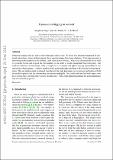Dynamics of digging in wet soil
Author(s)
Jung, Sunghwan; Hosoi, Anette E.; Winter, Amos G.
DownloadHosoi_Dynamics of digging.pdf (450.9Kb)
OPEN_ACCESS_POLICY
Open Access Policy
Creative Commons Attribution-Noncommercial-Share Alike
Terms of use
Metadata
Show full item recordAbstract
Numerous animals live in, and locomote through, subsea soils. To move in a medium dominated by frictional interactions, many of these animals have adopted unique burrowing strategies. This paper presents a burrowing model inspired by the Atlantic razor clam (Ensis directus), which uses deformations of its body to cyclically loosen and re-pack the surrounding soil in order to locally manipulate burrowing drag. The model reveals how an anisotropic body – composed of a cylinder and sphere varying sinusoidally in size and relative displacement – achieves unidirectional motion through a medium with variable frictional properties. This net displacement is attained even though the body kinematics are reciprocal and inertia of both the model organism and the surrounding medium are negligible. Our results indicate that body aspect ratio has a strong effect on burrowing velocity and efficiency, with a well-defined maximum for given kinematics and soil material properties.
Date issued
2011-05Department
Massachusetts Institute of Technology. Department of Mechanical Engineering; Massachusetts Institute of Technology. Hatsopoulos Microfluids LaboratoryJournal
International Journal of Non-Linear Mechanics
Publisher
Elsevier B.V.
Citation
Jung, Sunghwan, Amos G. Winter, and A.E. Hosoi. 2011 "Dynamics of Digging in Wet Soil." International Journal of Non-Linear Mechanics 46(4): 602–606.
Version: Author's final manuscript
ISSN
0020-7462